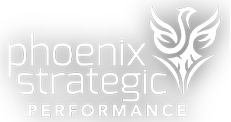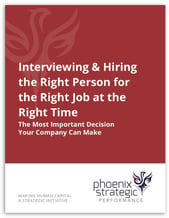To actively embed a robust Human Asset Management Strategy (HAMS) process into your organization, the organizational culture must reinforce the operating construct of the HAMS approach. One of the foundational norms is a culture of relevance which is also critical to a Human Asset Management Strategy. What does that mean?
We continually hear from our clients that they need dynamic thinkers who are intellectually curious from both a functional and enterprise perspective. They need employees who employ an integrated thinking approach regarding:
- their roles and their current and future skill / knowledge requirements (employability)
- their organization and their impact on the organization today and tomorrow
- the driving and changing forces of the outside world and that impact on their organization and their roles
The New Operating Context for a Robust Human Asset Management Strategy: The Relevance Factor
If the organization is operating in a dynamic environment, that environment must drive the role and competency benchmarks used based on the new operating paradigm. There is no room for static thinking.
Change Environments ARE Fundamentally different from Business as Usual (BAU) Environments
Just because an employee is good at a role within a more static, business-as-usual environment, doesn’t automatically mean the employee will be good in a more dynamic role. This is a foundational flaw that assumes the world of work has not changed and, of course, all employees can adapt because they are smart and ‘just can’. One knowledge and skill set does not automatically transfer to another.
Embedded in the HAMS process is both an organizational and individual view that must align. Using the If / Then Premise, here is a human asset management logic:
The "If" Premise:
If the organization is operating in a dynamic, changing environment
And If the current role and tasks involve both:
Routine work – business as usual
Trending Indicators: Positive – Neutral – Negative
Non-routine work – business based on change and new activities
Trending Indicators: Positive – Neutral – Negative
And if employees must keep strategic pace with and stay aligned to the strategy for both the routine and non-routine components of their roles...
The "Then" Premise:
Then we must evaluate employees dynamically based on both routine and non-routine work along with an assessment of trend indicators. In addition, we must continually rebenchmark the roles to reflect the changing environment.
Very often, these new roles and tasks have fundamentally different knowledge, skills and competency requirements. They are in a constant state of flux and change. We know that today’s knowledge and skills are becoming obsolete in 2 years or less depending on your company / industry. If that’s the case, the non-routine skills that people need to stay current and relevant must continually develop. In the future, non-routine work will overtake routine work. Routine work will be either outsourced or replaced by artificial intelligence or robotics.
Routine vs Non-Routine Employee Assessments
When we assess employees using the routine and non-routine scale together with the trending mechanism, here are the results:
- Routine work scores higher than non-routine work 65 - 70% of the time
- Trending scores:
- For routine work, the trending indicators are neutral to positive
- For non-routine work, the trending indicators are negative to neutral
To stay competitive in the marketplace, ‘skills and knowledge relevant’ is no longer an option but a strategic necessity. If not, what are the risks and consequences for the organization’s future? By neglecting future human asset needs today, are you sabotaging your organization’s future? These are the hard but necessary questions leadership must ask? These questions will challenge your views on people as static employees or dynamic employees and the valuable assets of your organization.
The Tyranny of Urgency – Staying Relevant is Hard!
In a business-as-usual (BAU) environment, skills stay relevant for a long time. In a change environment, knowledge and skills obsolescence is an organizational casualty.
Let’s be honest! In a cost-cutting and lowering head count environment while maintaining the same business levels, it is tremendously hard, if not impossible, for employees to easily stay relevant. Without thinking about it, we have created obsolete organizations hiding behind the illusion that people are staying relevant. After all, they are smart and they are busy. Of course, it will ‘just happen’. Newsflash – it doesn’t ‘just happen.’ Staying relevant requires a culture where relevance is modeled by senior staff, where there is an accountability to stay relevant and where relevance is rewarded.
It must be embedded in the culture, and that culture must be wrapped around the entire organization. Why? It’s too easy not to invest the time to stay relevant, using the tyranny of urgency as plausible justification. And, if only one or two employees stay relevant, that does not mean there is an overall culture of relevance. Everyday, the culture must inspire it, support it and make employees and managers accountable for it.
I’m Dancing as Fast as I Can – the Employee View
From an employee’s perspective, here’s what attempting to stay relevant without a relevancy culture supporting this effort feels like:
“I feel like I am on a treadmill and going very fast. As soon as I pace myself and feel comfortable, they turn up the speed of the treadmill and I need to recalibrate all over again. And once I have gotten myself to the new level, they turn up the speed of the treadmill again……and they then tell me I also need to jump on the stair climber….and can I do them both at the same time since both pieces are next to each other and it shouldn’t be that difficult. And, by the way, can I learn how to cook some nutritionally healthy meals – which should only take a few minutes…..”
A Case of Impending Irrelevance - A Walk Through a Retail Shopping Mall
We don’t need to look any further than retail to see how that industry has changed completely in the last 10 years. And, we know it will continue to change going forward. In this fast-paced, changing world, we see relics of obsolescence and irrelevance everywhere. Make sure you and your organization are not the relevance casualties of the future.
Think about your people using the Human Asset Management Strategy (HAMS) criteria. The results of this approach will highlight what your organization needs to do to ensure that your people stay the strategic, relevant and valuable assets they are today and into the future.
We invite you to download our latest eBook: "Human Asset Management Strategy: A New Approach", which provides a multifunctional operational guide to human capital capacity planning. You can also schedule a complimentary assessment with a member of our team.






